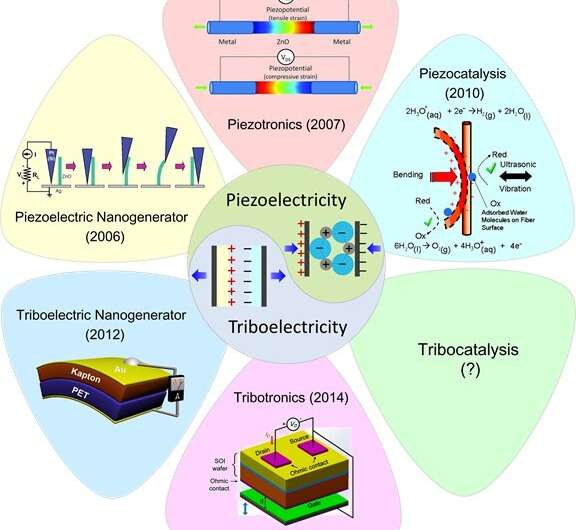Tribocatalysis: Challenges and perspectives

With an increasing global energy demands and environmental pollution, the development of alternative clean energy technologies has aroused widespread research interest. Harvesting and converting natural energy from the environment, such as solar energy, mechanical energy, thermal energy, chemical and biological energy, is one of the main sources of clean energy.
Among these energy sources, mechanical energy is one of the most widely distributed that is ubiquitously available and specialized for human motion-related applications. The harvesting and application of mechanical energy has important research significance and social value.
On the macro scale, the electrical energy converted from hydraulic and wind mechanical energy can meet the needs of people's daily life and production; on the micro scale, nanogenerators based on piezoelectric and triboelectric effects can also converted the mechanical energy in the surrounding environment and human movement into electrical energy.
Mechanochemistry is the coupling of mechanical and chemical phenomena on the molecular scale, and is an effective method for triggering chemical reactions through mechanical forces. The reaction pathways of mechanochemistry include force-induced degradation, activation, catalysis and initiation. Piezoelectric and triboelectric materials can generate electric charges on the surface in response to mechanical forces. Therefore, they can directly couple energy conversion with chemical reaction processes, especially catalytic reactions, and provide a new alternative method for mechanochemistry.
In recent years, piezoelectric materials have been employed as catalysts for water splitting and organic pollutants degradation, termed as piezocatalysis. In contrast, the triboelectric effect is rarely used in catalytic reactions, which means that the research field of tribocatalysis needs further exploration and development.
Recently, Dr. Feng-Ru Fan and colleagues in Xiamen University compared the principles of piezoelectric effect and triboelectric effect, and proposed new ideas for tribocatalysis and mechano-electro-catalytic effects to promote chemical reactions.
Through the triboelectric effect, the solid/solid interface or the liquid/solid interface realizes charge transfer and forms a local electric field and polarization. The charged surface or the local electric field can directly catalyze the reaction or promote the action of an exogenous catalyst. The author suggests using the new term "mechano -electro-catalysis" to describe this process. Piezocatalysis and tribocatalysis both belong to the category of mechano-electro-catalysis. In addition, a series of new research fields such as mechano-thermo-catalysis and mechano-photo-catalysis can also be derived. Mechano-electro-catalysis and tribocatalysis have potential applications in material synthesis and energy chemistry. They are expected to be applied to research fields such as organic synthesis, biomass conversion, water splitting, heterogeneous catalysis, energy harvesting and conversion.
The article was published in Sci. China Chem.
More information: Feng-Ru Fan et al, Tribocatalysis: challenges and perspectives, Science China Chemistry (2021). DOI: 10.1007/s11426-021-1089-6
Provided by Science China Press




















